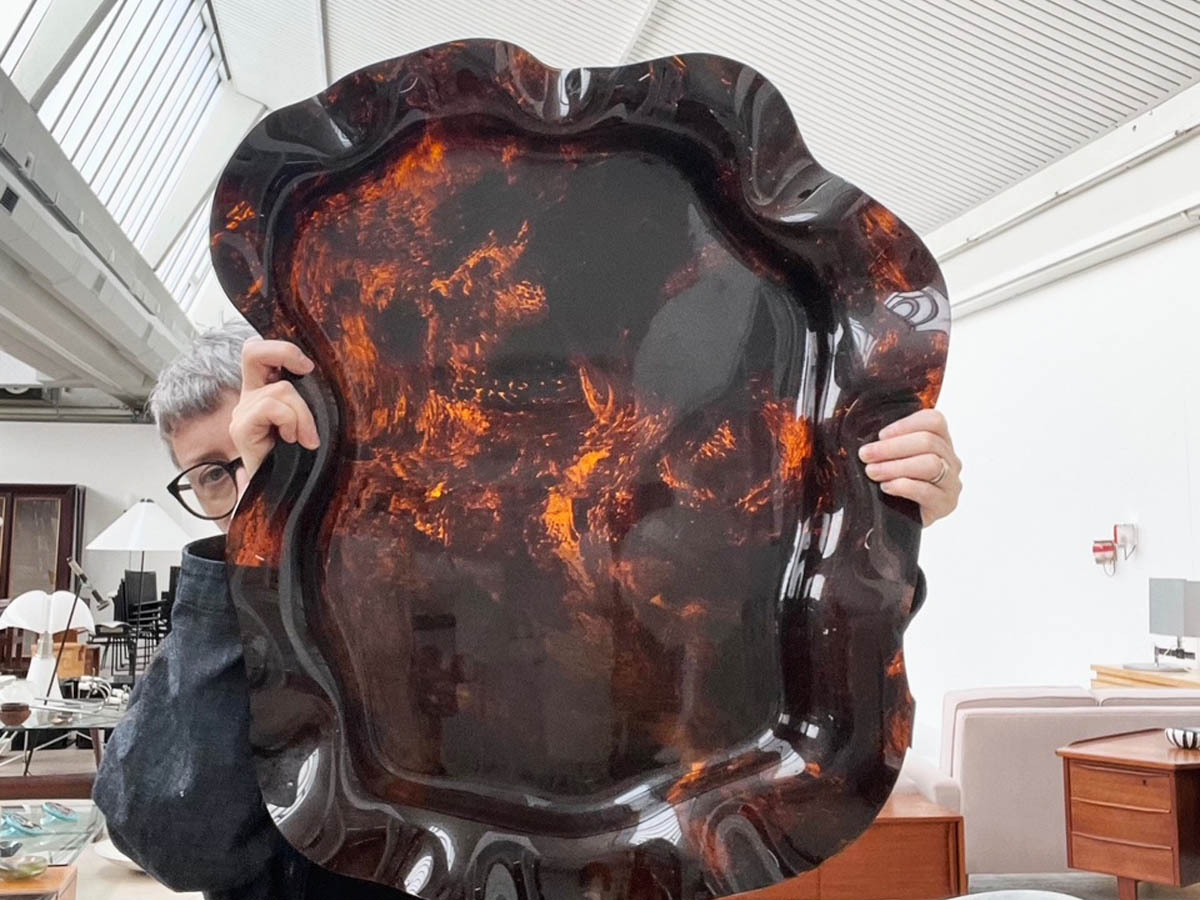Interview with Veruska Gennari and Demetrio Zanetti from Demos Mobilia
by Hanna Weissfeld for Formlicht – Design, Culture & Future Thinking.
Demos Mobilia has a history of more than 30 years. How did the gallery come about and what vision guided you from the beginning?
Demetrio : Ah, dear me, Demos Mobilia was born like certain fortuitous inventions: partly out of love, partly out of necessity, partly out of creative anger! I was in DAMS (in Bologna), and I had equal passion for markets than for classes. I would see thrown-away objects, real masterpieces, and I felt there was something to be saved. Then Veruska came along, with her lightning-fast eye and head full of ideas and visual poetry. At that point everything exploded: collecting, restoration, the desire to give dignity to things. The trade? It came later, almost out of hunger to keep looking.
Demos became our way of inhabiting the world. And it still is today: we save objects to save stories. And if someone then buys them, so much the better, so we can start over!
Veruska : Demos Mobilia was born from an instinctive gesture, from the tension between research and the need for meaning. In the beginning we were animated by a question: what really remains of an object when time passes?
We found the answer in the authenticity of materials, in the strength of a line, in the history that a piece of furniture carries with it. With a trained eye for form (thanks to studies in the applied arts) and a happy restlessness that has always driven us to seek the essential, we began to build a vision: to make the gallery a living place, where memory moves, not stored in formalin. Demos Mobilia is a daily exercise in attention-and yes, even beauty.
What do you think is the value of knowing the history of design in addressing the present and designing the future?
Demetrio : It is like wanting to build a rocket without knowing what gravity is. The history of design is the grammar of everything we use. It is full of brilliant mistakes, glorious failures and prophetic insights. Those who design without knowing it run the risk of making reheated soup or, worse, a chair that falls out from under you. For me, the past is a powerful fuel. I do not look at it with nostalgia, but with gratitude. It is the only way to imagine something that is not only “new” but also necessary.
Veruska : To know the history of design is to enter into dialogue with those who came before us. Every object comes from an urgency, a context, a vision.
And then let’s face it: how can you do graphics, architecture, design-anything visual-without knowing where the forms came from? History is a working tool, not nostalgia. It is only by knowing what has been-the mistakes, the utopias, the silent revolutions-that we can design with conscience. And with a little grace, which never hurts.
Many of the pieces in your collection bear the signatures of great masters. How does the selection take place?
Demetrio : So… the official criterion is “lightning strike with brains.” If an object doesn’t jolt our hearts and light a light bulb, it doesn’t fit. We may find a museum piece, but if it doesn’t speak to us, we don’t want it. We don’t care about names for show: we look for objects with character, with soul. They must have something resolved and something unresolved. Because unsettledness, when it is well done, is also design.
Veruska : We do not select by name or trend, but by meaning. Every object that enters the gallery must have a voice, must ask questions, leave traces.
We have a soft spot for objects that surprise you when you look at them sideways, those with small flaws full of meaning. Selection is a graphic, almost musical exercise: rhythm, emptiness, tension, harmony. If a piece doesn’t “play,” it doesn’t fit. We look for objects that can stand in time, like certain typefaces: always legible, never shouted.
What role does “beautiful” play in your daily work? And what does “beautiful” mean to you today?
Demetrio : Ah, the beauty! It’s not like it’s window stuff. Beauty is like good bread: rough crust, living crumb. It’s in the real materials, the firm mark, the proportions that make you say “ah!” For me today, beauty is something that holds the gaze and also the weight of years. It is never trivial, and it is never just for show. If it’s just show, it tires me out. True beauty keeps me company even when the light is off.
Veruska : Beauty is never just a matter of aesthetics. It is depth, rigor, truth. It is that silent quality that surfaces in details: a perfect fit, an unconcealed screw, a surface that tells time.
I have always been wary of “beauty that pleases everyone.” For me, beauty has to disquiet a little. It has to make you stop. Today true beauty is also courageous: it doesn’t waste, it doesn’t steal the show, but it builds bonds. Like a good composition: it accompanies you without explaining everything.
Demos Mobilia is much more than a gallery: it is a living archive. How do you integrate historical research with contemporary proposal?
Demetrio : Look, our repository is like a brain that never sleeps. We acquire pieces as others collect poems. Every object has something to teach us, every author is an old traveling companion. And history, the real kind, is always contemporary. When we offer a piece, we don’t do it for fashion: we do it because it has something to say now. The archive is alive because we talk to it every day. And sometimes – I confess – it even responds to us.
Veruska : The archive is not a repository; it is a moving organism. Every piece we acquire, every author we delve into, helps us read the present better.
It is like making a collage: historical research gives us the clippings, but we find the balance. We are not looking for nostalgic quotation, but for continuity of thought. The archive lives only if it breathes with the present. And each selected object is a piece that holds a vision together, like the scattered pages of an infinite graphic notebook.
The sustainable aspect is an integral part of your DNA. How does design reuse and conservation represent a concrete green act?
Demetrio : We were “green” before it went green. Every object we restore is a rescue from the landfill, an antidote to fast furniture. But we don’t do it for fashion: we do it because it’s right. The world is full of useless stuff that ages badly. We restore what makes sense. Besides, restoring is beautiful: it’s like giving an old friend a second chance. Or, if you like, it’s a bit like fixing the weather.
Veruska : Reclaiming an object is a radical gesture. It means saying no to waste, to blind production, to planned obsolescence.
For me, it is also a form of affection: putting back a piece of furniture is like healing a forgotten word. Sustainability, for Demos Mobilia, is not a style, it is a grammar. A way of being in the world with more lightness and a lot of responsibility. It is the only green we are interested in: that which is not said but done.
Today there is a lot of talk about circular economy: Demos Mobilia has been a pioneer of this. How does this philosophy translate into your daily work?
Demetrio : But we had already spun the wheel! Circular economy, for us, is rule number one. We don’t throw anything away: we repair, reinvent, reuse. We collaborate with artisans who talk with their hands, we use only gentle materials, and we treat each piece with the dignity you give to an old master. For us, every piece of furniture has a second (and maybe even a third) life. It is an economy, yes-but also a poetics.
Veruska : For us, the circular economy is not new; it is our natural way of working.
Every object we restore, every collaboration with a craftsman, every choice of material is made with care and sense. We work on the existing, we use what is there, we enhance what many people no longer see. It is both an aesthetic and political act. Kind of like paginating well: removing the superfluous, leaving only what matters.
Is there an object, story or author that, more than others, embodies the soul of Demos Mobilia?
Demetrio : Jean Prouvé, without a doubt. He was a genius with his sleeves rolled up. He made dismountable houses, furniture for everyone, and all with a consistency that is almost subversive today. He was a humanist engineer, a poet of sheet metal. His design is political, but not ideological: it is concrete, useful, just. Everything we love is in him: intelligence, generosity, future. Sure, now his pieces cost like a house, but whatever-he made them for everyone. We at least remember him that way.
Veruska : Impossible to choose one. Demosmobilia is not an altar for a single name, it is a generous and layered melting pot, where the works of past visionaries who revolutionized the way we experience the home and think of furniture not as a possession but as an extension of thought coexist.
It is a constellation of radical gestures, silent inventions, flashes of functional beauty. It is a constellation of radical gestures, silent inventions, flashes of functional beauty. It is the place where Gio Ponti can converse with an anonymous carpenter from the 1950s who can move as much as an acknowledged master.
Our soul is not in one object: it lives in the tension between them all.
And it is precisely in this way then that we really furnish houses: fishing from everything that moves us, that tells and represents us, that looks like us.
What is the biggest challenge in telling the value of historic design in a world accustomed to novelty at any cost?
Demetrio: The challenge is to make it clear that the new is sometimes just an old man in poor disguise. We live in the age of “now,” but historic design demands time. It is like a wine that has to be decanted. You have to be patient, willing to listen. That’s what our work is all about: slowing down the world, sitting people down, telling the stories inside objects. Because a piece with seventy years on its back can be more revolutionary than a start-up.
Veruska : The challenge is to make it clear that new is not always progress. And that slowness is not a defect.
We live in a world that also consumes images. But historical design asks for slower, deeper looks. Every object tells a gesture, an idea, a need. It is up to us to give it back its voice. Our job is this: to accompany the gaze, to slow it down, to offer it another rhythm. Like making a good composition: you need pauses and silences, not just effects.
If you could leave a message for the next generation of designers and collectors, what would it be?
Demetrio: Guys, put away Instagram for a moment and touch real things. Go to markets, smell chairs, talk to carpenters. Be curious, not crafty. Don’t make objects to sell: make them to change something. And you collectors: don’t buy status, buy stories. Design is not about signatures, it’s about thinking. And remember: a good object makes your day better. A great object changes your mind.
Veruska: Ask yourself everything. And listen to the objects.
Don’t follow fads: look at the details, look for consistency. Collecting is not owning, it is cherishing. Designing is not “liking,” it is taking responsibility.
And a personal piece of advice, from – now former – graphic designers and women: use beauty with respect. It is a powerful language, but also a fragile one. And above all, have courage. Not to overdo it, but to say something true.
Demos Mobilia is made by Demetrio Zanetti and Veruska Gennari
Demetrio Zanetti (1959)
Born in a tiny Swiss village of 800 souls, growing up among grape vines, broken-down bicycles and slow ticking clocks, Demetrio Zanetti’s heart has always been divided between the stage and the workbench. In his early twenties he moved to Bologna, where he studied Theater and Film and treaded the boards as a theater actor for more than a decade. But it is among the materials that he begins to play his longest part: that of the visionary antiquarian.
For over thirty years he has been the soul of Demos Mobilia, restoring voice and soul to forgotten objects with the respect of the restorer and the madness of the poet. He works with wood, metal and resin as if they were characters to be rewritten, always poised between the past and invention.
For Demetrio, every chair has a gesture. Every table, a joke. Every well-made piece of furniture, an idea of the world. And if you ask him what design is, he replies, “It is a form of theater. Only here the actors are the objects. And they last much longer than humans.”
Veruska Gennari (1970)
Founder and director of Demos Mobilia, Veruska Gennari is a figure who combines cultural vision, aesthetic sense and deep expertise in the field of historical design. Born in 1970 and trained in applied arts and graphic design, she has built over the years a gallery that is much more than an exhibition space: it is a laboratory of ideas, a living archive and a critical platform for rethinking the relationship between form, function and time.
Guided by an indefatigable curiosity and a rare ability to read objects as traces of thought, Veruska selects each piece with a keen eye for design coherence, ethics of reuse and cultural value. Her voice, balanced between rigor and lightness, has given Demosmobilia a distinct recognition in the mid-century modern design scene: a space where the past is not preserved, but transmitted.



